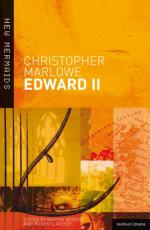|
This section contains 775 words (approx. 2 pages at 400 words per page) |

|
In this essay, Clare provides an overview of Marlowe's play, contrasting its comparatively sparse narrative style to the playwright's other works, notably Tamburlaine and Doctor Faustus.
In Edward II, arguably his last play, Marlowe departs from the foreign and exotic landscapes of earlier drama and turns to English history to write a de casibus political tragedy. The King's infatuation with the young Piers de Gaveston leads to growing opposition from the barons, spearheaded by the Earls of Lancaster and Warwick, Mortimer, and his nephew, young Mortimer, who becomes the principal antagonist. Resentment of Edward's culpable neglect is fuelled by Gaveston's lowly origins; he is dismissed scornfully by Mortimer as "one so base and obscure". Edward greets such hostility with defiance but the barons are powerful enough to coerce the King into agreeing to Gaveston's banishment. However, they then work to have him recalled so that they can...
|
This section contains 775 words (approx. 2 pages at 400 words per page) |

|




